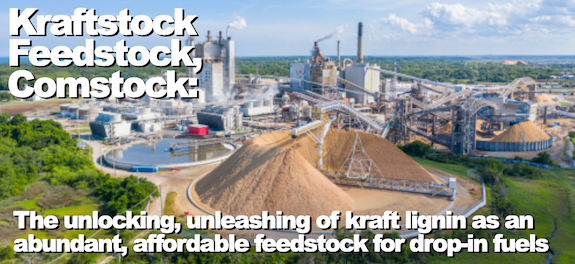Kraftstock, Feedstock, Comstock: the unleashing of kraft lignin as an abundant, affordable feedstock for drop-in renewable fuels

Nine days ago, in the story “Molecules for Christmas,” Dr. Brian Westlake opined that “the answers to all your questions are in the forest” and further evidence of his prescience arrives this week from Virginia City, Nevada, where Comstock Fuels unveiled a remarkable partnership, investment and pathway to drop-in renewable fuels focused in this announce on Europe, that we reported on (here is the Digest brief and here’s the full release).
What are the consequences, the “if so, then what” of this series of announces?
First, let’s recap the highlights. First, Comstock has made an investment in RenFuel technology, the focus is to assure that RenFuel has the resources to complete some additional R&D that will broaden the applications of the technology they have already brought to commercial readiness. Second, Comstock has secured the North American rights to the technology and now has options elsewhere around the world, including an option to acquire the entire RenFuel subsidiary — a JV with Preem — that owns the worldwide technology rights. Third, there’s a sizable refinery that is expected to be developed and ready by the end of 2025, in Sweden.
So, what’s the tech? RenFuel has developed a technology to esterify kraft lignin, making it suitable for hydrotreating and in the end producing a drop-in renewable fuel, either SAF or renewable diesel. Now, the HEFA process for hydrotreating virgin oils to make SAF and renewable diesel is widely known and commercialized, nowadays — it’s the primary established technology for making those important fuels. The problem has been the availability of waste oils and the cost of virgin oils.
Nothing affordable to process? Nothing to talk about. That’s been the SAF dilemma. Companies such as Alder have labored mightily to break the logjam by producing more fatty acids — in their case, volatile fatty acids, via anaerobic digestion, opening up new feedstocks and certainly a path into the forest. Yet, it’s early days for those sorts of tech, and solutions are needed now that broaden the feedstock pool and chop the price.
Looking at markets, prices and volumes
So, let’s discuss kraft lignin for a moment. It’s the leftover from the kraft pulp process, and kraft lignin has conventionally been dissolved into black liquor and burned in a boiler to provide process heat and power for pulp mills.
There’s a lot of it — pulp, of course, but also kraft lignin. Says here there are 55 million tons of it produced globally each year.
That’s 16.5 billion gallons if you are calculating the volume instead of the weight. In short, enough to replace 50 percent of US aviation fuel with a feedstock currently used for power & heat generation, and which has roughly half the energy content of coal, says here. That’s roughly $53 per ton in value, based on the current price for coal.
So, let’s consider what we have. A $53 per ton feedstock — that’s 2.6 cents per pound. Now, we’ve priced this using coal as a benchmark, oil trades at $12.75/million BTUs, coal trades at around $5.15/MMBTUs, right now. If you get your calculator out, you’ll get to a feedstock cost of $18.37 per oil barrel equivalent.
That’s super duper cheap. And, we’ve priced it not on market price but on (power & heat) utility price to the pulper for the current application. And, it’s already aggregated at the plant.
So, kraft lignin. Interesting play. And, yes, there’s been research on esterifying it. Here’s is one article you might find, here’s another — and here’s another on hydrotreating it.
Looking at the implications
So, do Comstock and RenFuel have the locked-down, ready for scale, process for converting kraft lignin to a renewable fuel? That’s something that’s behind the corporate kimono — certainly, that’s the claim. And there’s considerable reason to add up all the activity in the EU around petroleum to renewable diesel refinery conversion, not to mention the activity of Preem and Comstock, and conclude that they have it nailed.
Wouldn’t that be something? But let’s go a step farther down the road. Let’s consider what pulp plants have aggregated for us, besides kraft lignin. That’s the cellulose and hemicelluose — the very cellulosic biomass that’s been the subject of so much hope, investigation and development. And the very biomass that Comstock’s core technology works with — forest biomass.
If you were to look at the challenges of cellulosic fuels and point to the problems of cost and in particular the cost associated with aggregating, separating and dealing with lignin — and you have reasons to prick up your ears. Yes, there’s been a lot of success with cellulosic, at small scale, in parts of the world, think Iogen technology in Brazil.
What made Iogen technology work so well. Why is Praj coming along so fast? For one, a great process. Add blood, sweat and tears. And add something else, sugarcane.
What’s special about that? Well, plenty of things to do with cane sugars. It was the residue that was the problem – bagasse, vinasse, press-mud. The great technologies have been working on the residues.
The Great Wall of China has been lignin. Imposing, costly, frustrating to invaders. But, eventually does not keep out the Mongol horde — as in the wars of the steppe, in renewable fuels, technology finds a way, and reveals that the Great Wall was not perhaps as forbidding as it was designed to be.
So, barrier smashed? We’ll know more as the technology rolls out. Barrier threatened? For darn sure, the biomass barbarians are at the gate. $15 per barrel of oil equivalent, already aggregated, available at massive scale, worldwide, technology reputed to be ready or purty darn near, can be massively supplemented by cellulosic fuel conversion with the remaining fraction?
Wow.
Category: Top Stories















